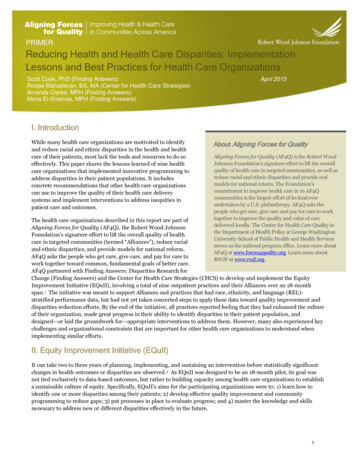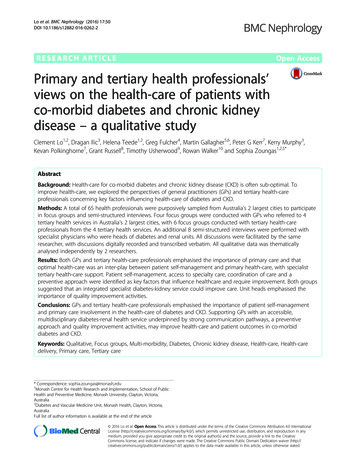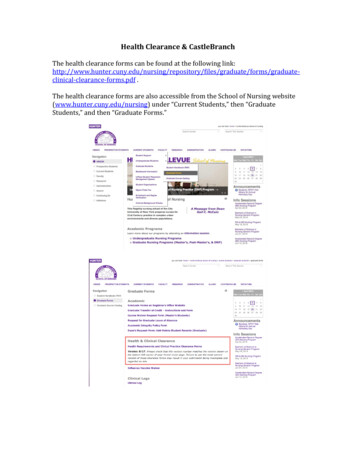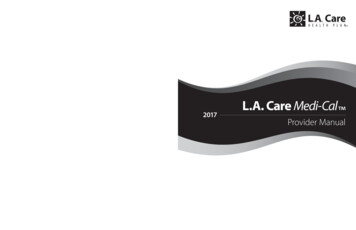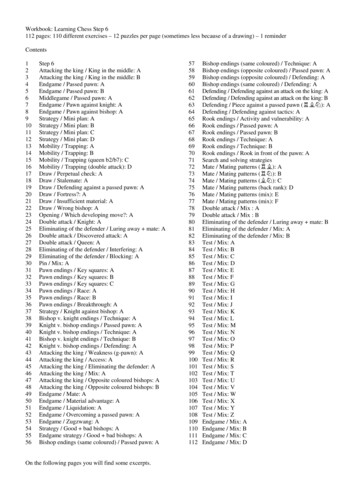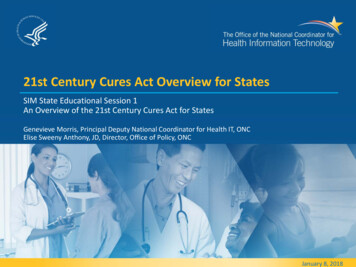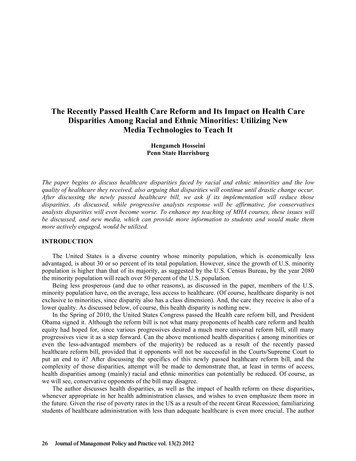
Transcription
The Recently Passed Health Care Reform and Its Impact on Health CareDisparities Among Racial and Ethnic Minorities: Utilizing NewMedia Technologies to Teach ItHengameh HosseiniPenn State HarrisburgThe paper begins to discuss healthcare disparities faced by racial and ethnic minorities and the lowquality of healthcare they received, also arguing that disparities will continue until drastic change occur.After discussing the newly passed healthcare bill, we ask if its implementation will reduce thosedisparities. As discussed, while progressive analysts response will be affirmative, for conservativesanalysts disparities will even become worse. To enhance my teaching of MHA courses, these issues willbe discussed, and new media, which can provide more information to students and would make themmore actively engaged, would be utilized.INTRODUCTIONThe United States is a diverse country whose minority population, which is economically lessadvantaged, is about 30 or so percent of its total population. However, since the growth of U.S. minoritypopulation is higher than that of its majority, as suggested by the U.S. Census Bureau, by the year 2080the minority population will reach over 50 percent of the U.S. population.Being less prosperous (and due to other reasons), as discussed in the paper, members of the U.S.minority population have, on the average, less access to healthcare. (Of course, healthcare disparity is notexclusive to minorities, since disparity also has a class dimension). And, the care they receive is also of alower quality. As discussed below, of course, this health disparity is nothing new.In the Spring of 2010, the United States Congress passed the Health care reform bill, and PresidentObama signed it. Although the reform bill is not what many proponents of health care reform and healthequity had hoped for, since various progressives desired a much more universal reform bill, still manyprogressives view it as a step forward. Can the above mentioned health disparities ( among minorities oreven the less-advantaged members of the majority) be reduced as a result of the recently passedhealthcare reform bill, provided that it opponents will not be successful in the Courts/Supreme Court toput an end to it? After discussing the specifics of this newly passed healthcare reform bill, and thecomplexity of those disparities, attempt will be made to demonstrate that, at least in terms of access,health disparities among (mainly) racial and ethnic minorities can potentially be reduced. Of course, aswe will see, conservative opponents of the bill may disagree.The author discusses health disparities, as well as the impact of health reform on these disparities,whenever appropriate in her health administration classes, and wishes to even emphasize them more inthe future. Given the rise of poverty rates in the US as a result of the recent Great Recession, familiarizingstudents of healthcare administration with less than adequate healthcare is even more crucial. The author26Journal of Management Policy and Practice vol. 13(2) 2012
believes that utilization of new media technologies can help enhance teaching the recently passed carereform and its impact on the health situation of minorities ( and other less advantaged persons) in the U.S.in our graduate courses in health administration. After all, today’s students are technologically savvy.Since a great deal of information about the debate that led to the passage of the healthcare reform bill, orinformation about health disparities, are available online, today’s students are capable of seekingknowledge and active learning through the new information technologies that they regularly use in theirdaily lives. Utilization of the new technology sources such a Blackboard, Discussion Board, Wiki, Blog,Second Life and Skype , and the interaction, and communication resulting these technologies, canenhance teaching by complementing information contained in textbooks, academic journals, or theinformation provided through lecturing. In other words, the information about the above obtained throughBlackboard, and the interaction resulting from those technologies, can be well-integrated in the graduatecourses in our MHA program.Health Disparities in the United StatesAs stated above, health care disparities are a fact of life in the United States. For, racial and ethnicminorities, immigrants, those are not proficient in English, and even many less educated /less prosperouswhites have less access to health care services , and to the quality of healthcare they receive. As stated byBrian Smedley of Health Policy Institute, in the United States: “Healthcare disparities are not new-theyare a persistent relic of segregation and inadequate healthcare for communities of color.” (2009, p. 2). Tohim “Like access to other opportunities, healthcare for minorities suffered from government inattention(and in some cases, explicit blessing of inequality) for over 100 years after the end of the Civilwar.”(Ibid).As stated above, health disparity in the United States is not new. In his 1944 classic study, SwedishNoble Prize economist /social theorist Gunnar Myrdal, comparing the healthcare of the American whitesand black (then by far the largest racial minority in the United States) stated that: “Area for area, class forclass, Blacks cannot get the same advantages in the way of prevention and care of disease that Whitescan”. (Quoted by Hengameh Hosseini, 2010, p. 113).Forty one years later, and almost twenty years after the inception of Medicaid/Medicare, the Report ofthe Secretary’s Task Force on Black and Minority Health (DHHS 1985) concluded that “Despite theunprecedented explosion of scientific knowledge and phenomenal capacity of medicine to diagnose,Black, Hispanics, Native American and those of Asian/Pacific Islander heritage have not benefited totallyor equally from the fruits of science or from the systems responsible for translating and rising healthtechnology”.And, more than two decades later than the above report, Byrd and Clayton stated the following:“Despite steady improvements in the overall health of the United State’s population, thehealth of American’s racial and ethnic minorities varies from the mainstream. Forexample, the health status of African Americans- a racial-ethnic group already burdenedwith deep and persistent history –based health disparities-has been recently characterizedas tangent or deteriorating.” (2003, p. 455).To emphasize their argument/point, those two authors stated that:“A body of nearly 600 scientific publications documenting racial and ethnic disparities inhealthcare provides ample evidence of this problem.” (Ibid).The above should not imply that healthcare disparities are exclusive to minorities, since they also existamong less advantaged whites in the United States.The impact of less access to healthcare and its quality can be seen in the following statistics, assuggested in the U.S. Department of Health and Human Services sources (2006). The likelihood of diabetes among Native Americans and Alaska Natives is more than twice thatof the average of all in the United States.Journal of Management Policy and Practice vol. 13(2) 201227
Among Black Americans, the age-adjusted death rate for cancer is approximately 25 percenthigher than for white Americans.The black-white gap in infant mortality during 1980-2000 time periods widened.African –Americans have a 6-10 fewer years of life expectancy than white Americans. Accordingto Wolf-Johnson, et al, had mortality rates for African-Americans been equal to those of WhiteAmericans in that period, over 88000 deaths among African Americans would have beenprevented.Racial and ethnic minorities in the United States experience significant disparities compared to whitesin terms of both access to healthcare and the quality of healthcare they receive. According to a 2006report by the U.S. Agency for Healthcare Research about healthcare disparities in the United States,minorities in the United States had much less access to healthcare, and for various health measures.According to that report, Hispanics/Latinos experienced the worst access problems of all ethnic groups.While in 17 percent of health measures they (Hispanics) had the same access; in the remaining 83 percentof measures Hispanics/Latinos had by far less access than whites. According to the same study, minoritygroups also fared poorly in health quality as compared to whites. According to that report, AfricanAmericans receive poorer quality of healthcare than white Americans on 73 percent of measures ,Hispanics/Latinos receive 77 percent of those measures , Asian Americans on 32 percent, and NativeAmericans receive 41 percent. According to Smedley, “ from 1999 to 2004 the proportion of adults age65 and over who received a pneumonia vaccine increased for whites ( from 52 percent to 59 percent) butdecreased for Asians ( from 41 percent to 35 percent), and from 2000 to 2003 colorectal cancer screeningrates increased for whites while falling sharply for American Indians and Alaska Natives.” (2009, p.3). Asargued by Smedley, “these growing gaps are not unexpected given that the increase in the numbers of theuninsured has been more dramatic in communities of color than in non-minority communities.” (Ibid).Even for those with health insurance, health disparities persist. In fact, a substantial body of evidencedemonstrates that racial and ethnic minorities receive a lower quality and intensity of healthcare thanwhite patients, even when they are insured at the same levels, have similar incomes and present with thesame types of health problems. Examples (provided by the above author) are the following: African-Americans with health insurance are less likely than white- Americans with healthinsurance to receive many potentially life-saving or life extending procedures, particularly hightech care, such as cardiac catheterization, bypass graft surgery, or kidney transplantation. Black American cancer patients fail to get the same combinations of surgical and chemotherapytreatments that white Americans with the same disease presentation receive. African-American heart patients are less likely than white American patients to receive diagnosticprocedures, revascularization procedures and thrombolyic therapy, even when they have similarincomes, insurance and other patient characteristics. According to Smedley, the same is also true of routing care. He gives the example of AfricanAmerican and Hispanic/ Latino patients who are less likely than whites to receive aspirin upondischarge following a heart attack, to receive appropriate care for pneumonia and to have painsuch as the kind resulting from broken bones- appropriately treated. U.S. Minorities are also less likely to receive treatments such as limb amputation for diabetes.Disparities also exist in long-term care. While U.S. minorities constitute the fastest-growingsegment of U.S. population, and are burdened with a higher prevalence of chronic diseases, thusrequiring more long term care, yet minority patients are less likely to receive long-term care. (SeeMN AKhter and AR Levinston, 2003, pp. 88-93). The same can be said of dental service.Eliminating those healthcare disparities is a desirable goal, not only because it is humane and isthe right thing to do, but also because it is good economically. In fact, in their 2009 study entitled“The Economic Burden of Health Inequalities in the United States”, Laveist, Gaskin, andRichard, demonstrate that reducing health inequality is in fact beneficial economically. In theexecutive summary of their study, those authors argue the following:28Journal of Management Policy and Practice vol. 13(2) 2012
“We estimated the economic burden of health disparities in the United States using threemeasures: 1- Direct medical costs of health inequalities, (2) indirect costs of health inequalities,and (3) costs of premature death. Our analysis found:Between 2003 and 2006 the combined costs of health inequalities and premature death in theUnited States were 1.24 trillion.Eliminating health disparities for minorities would have reduced direct medical care expendituresby 229.4 billion for the years 2003 and 2006. (p.1).Between 2003 and 2006, 30.6% of direct medical care expenditures for African Americans,Asians, and Hispanics were excess costs due to health inequalities.Eliminating health inequalities for minorities would have reduced indirect costs associated withillness and premature death by more than one trillion dollars between 2003 and 2006.” (p.1).The New Health Care Reform and Its ImpactProgressives in the United States have for a long time advocated reform of the American healthcaresystem, and have desired some type of universal coverage. Among American progressives, includingmany physicians, have even supported a single –payer system. In fact, the Journal of American MedicalAssociation, in its August 2003 issue, included a proposal for a single –payer system that was proposedby a large number of physicians. That proposed single-payer system had the following attributes: A single –payer Comprehensive coverage without co-payments and deductible. Maximum choice of doctors, nurse practitioners and hospitals. Improved quality. Expansion of primary care. Publically-funded, but privately delivered.More recently, in fact when the recently-passed health reform bill was being debated in the congress,Congressman Conyers ( D-Michigan) and 85 other members of the U.S. House of Representatives alsoadvocated a single-payer system, as did many other progressive Americans and Democrats. Of course,President Obama and some Democrats advocated a system that was less drastic than a single-payersystem and included what became known as Public Option. Of course, Republicans and conservatives(including conservative Democrats) in the U.S. opposed any government involvement in the healthcaresystem-thus opposing the single-payer system, the Public Option or even a lesser governmentinvolvement. In fact, even Obama’s Public Option was rejected by the U.S. Congress, thus leading to thebill that was eventually passed in March 2010.In the spring of 2010, the United States congress passed the Health care reform bill, and PresidentObama signed it. (Of course, its future is not very certain, since more conservative states have begun totake it to the courts. This is why the 11th Circuit Court of Appeals found its individual mandateunconstitutional). Although the reform bill is not viewed as a perfect one by the most progressiveelements in the U.S. still it is viewed as a step forward by many progressives, believing that it isproviding health insurance to millions of uninsured Americas, preventing insurance companies fromdenying health insurance companies from denying health insurance to individuals with pre-existingconditions, and other positive points. These include: to incentive small business owners to cover theiremployees, to establish new competitive health insurance markets, and to bring greater accountability tokeep premiums down and prevent insurance industry abuses and denial of care. The bill also providedcertain benefits to the elderly. Case in point is the coverage for the so called donut hole. Under theMedicare Prescription Drug plan or Medicare part D., Medicare Part D is a federal program established tosubsidize the cost of prescription drugs for Medicare beneficiaries which was enacted-under PresidentGeorge W. Bush in 2003, and went into effect in January of 2006. Donut hole is the coverage gapbetween two cash benefits when an individual has to take full out –of pocket responsibility for the cost oftheir prescription drugs. Under the Medicare Prescription plan, once a senior reaches 2,250 of drugJournal of Management Policy and Practice vol. 13(2) 201229
costs, he/she will have to pay 100% of the next 2,850, before Medicare part D covers drug costs again(which is called the donut hole). Once the senior has purchased 5,100 in covered prescription drugs, thesenior’s costs are again covered. However, the Health Care and Education Reconciliation Act of 2010section 1101 provides for a 250 rebate to Medicare beneficiaries who reach the part D coverage gap in2010. In any quarter when an individual reached the threshold for the donut hole coverage gap, Medicare,by the 15th of the third month following that quarter, shall send a 250 rebate (being entitled to only onesuch rebate). Additionally, starting in the year 2011, Medicare will provide free annual wellness visitsand personalized prevention plans. Of course, Medicare will be required to cover such services with noco-pay.There seems to be more unpublicized benefits to the elderly. According to June, 2010, AARPBulletin, the health care bill has set aside 20 billion over five years to encourage states to use Medicaiddollars to help older people transition out of nursing homes to move independent living arrangementstheir homes or assisted living. The bill is also supportive of preventive medicine. According to a Junestatement by Health and Human services Secretary Kathleen Sibelius, the bill will allocate 250 millionfor public health initiatives on preventing measures that concern chronic diseases that also deal with thecurbing of tobacco and alcohol abuse. The bill has also allocated 500 million as Prevention and PublicHealth Fund as a part of Medicare. This provides money, through grants, to community clinics andhospitals, and to those who do research. Beginning with 2011, Medicare patients will have free access toall preventive screening and tests that include mammograms, colonoscopies and annual comprehensivephysical exams. At present, Medicare patients have had to pay 20 percent of the cost of these measuresand use their yearly deductibles. As emphasized by Center for Medicare Advocacy, Inc., in the newlypassed health care bill, Medicare Advantage Prescription Drug Plans may not manipulate premiums forlow-income beneficiaries in order to force them into other plans. However, health and human servicesecretary has been authorized by the newly-passed bill to auto-enroll low-income beneficiaries who havelost their plans into more advantageous plans. In fact, beginning with January 2011, a person whosespouse has died in the middle of a low-income eligibility period will have the opportunity to continue thatplan by exactly one more year after the person’s eligibility would discontinue. Further, the person mayalso reapply for that low-income benefit, if qualified. Very often, poor elderly who receive Medicarebenefit cannot get the full benefits of Medicaid if they are under home care or in a nursing facility. Asemphasized by Garry Matters in his “Health Care Reform Benefits for Elders”(June 26,2010), beginningwith January 1,2012, the reforms call for the elimination of cost-sharing (co-pays) for part D drugs for allfull benefits, dual-eligible beneficiaries who receive both Medicare and Medicaid at home or in a nursinginstitution. This provision, supposedly, creates equity in part D cost sharing between those in institutionsand those getting the same services at home or in assisted living.Needless to say that the bill passed in March 2010 has had many opponents, including those who findaspects of it unconstitutional. Many conservatives believe the Federal Government has no right to forceindividuals, businesses, etc. to purchase health insurance (explaining why various states have taken theissue to Federal courts).Interestingly enough, some conservative opponents of the above bill have opposed it on the groundsthat it even widens healthcare disparities. For example, Kathryn Nix, in her September 14, 2010 article“Side Effects: Obama care widens Health Care Disparities” criticized President Obama’s statement to theSpanish media that the new health reform law would ensure that minorities like Latino’s would haveaccess to health care services through better coverage options. In her critical response to PresidentObama’s statement, Kathryn Nix made the following points:1. “This coverage is pushing many Hispanic and African Americans into an inefficient program thathas seen a sharp drop in physician participation. Obamacare puts an additional 16 millionAmericans into Medicaid, a poorly performing welfare program”.2. The expansion is expected to exacerbate problems that riddle the poor performing programnamely, poor quality and low reimbursement rates to primary care providers that have resulted ina physician shortage for Medicaid patients.30Journal of Management Policy and Practice vol. 13(2) 2012
3. Only about half of U.S. physicians accept new Medicaid patients, compared to 70 percent whoaccept Medicare patients.4. Minority populations will be disproportionately forced into Medicaid, while Americans withhigher incomes will receive generous subsidies to buy private insurance.5. Ultimately, expanding Medicaid will further divide American healthcare into two tiers.6. Increasing the number of Medicaid beneficiaries will make it more difficult for present Medicaidpatients to find doctors, and Of course, progressives disagree. As we will see, to them, the reform law is a step forward, includingin its ability to reduce healthcare disparities.Would the above changes contained in the new healthcare law improve the healthcare of UnitedStates’ minority population, leading to the reduction of health disparities? Obviously, if maintained, thenew reform bill will benefit U.S. minorities, since they are disproportionally poor. Among the benefits tominorities leading to a reduction in health disparities, we can include the following: Since the bill is expected to provide health insurance coverage to 32 million people who arecurrently uninsured, and because the uninsured are more likely to be minority, minorities will endup with more access to health insurance, thus care. According to the bill, subsidies are to be provided to individuals and families who make 100percent-400 percent poverty level (which include a larger minority population) and want topurchase their own insurance. This too will to provide more insurance, thus more healthcare, tominorities. Starting with 2010 (after its passage of March 2010), according to the bill, insurance coveragewas extended to dependent children (young adults) until they are 26 years old. Since minorityyoung adults are much more likely to be unemployed, thus without insurance, minorities wouldbenefit from this coverage more than others. Under the healthcare reform bill, after 2014, most uninsured (thus minorities) who are currentlyuninsured will either obtain coverage through Medicaid’s expansion or through governmentsubsidies, thus providing more healthcare coverage.The above changes in the health care system, especially those leading to more insurance and access,will lower health disparity to the extent that it provides more access. However, since the healthcarereform bill does not deal with all dimensions of health disparity, thus not providing access to everyone, itcannot end health disparity all together thus, although the newly passed health care reform legislation is astep forward and provides various benefits to the public, it is not by any means perfect. While it isadmirable that more people have access to health insurance , that insurance companies do not and cannotdeny health insurance to those with pre-existing conditions, and , the United States still faces thechallenges of the rising cost of health care which , to a large extent, stems from the aging of Americansociety. In fact, in the long run, if the rising health care costs continue, these costs will not be sustainable,to the extent that Medicare and Medicaid programs will collapse, and individuals for the most part willnot be able to purchase private insurance. These require drastic cost reducing measures.Utilizing New Media Technology in Teaching MHA CoursesIn her attempt to improve the teaching of her MHA courses (whether on -line or on-campus),including her attempt to familiarize her students with healthcare disparities in the United States, therecently –passed healthcare reform and its impact on health disparities, the author has found that byintegrating new technologies into these courses, students become more engaged; each of the newtechnologies utilized will enhance the coordination, collaborations and communication needed to achievethe objectives of each of the courses the author teaches. In other words, students can meet the neededcompetencies and objections in each of my courses if I utilize Blogs, Wikis, Second Life, Skype and othersuch new technologies. In fact, one of the challenges faced by those of us in the academia today,Journal of Management Policy and Practice vol. 13(2) 201231
including in our field of healthcare administration, is to engage and meet the requirements of computersavvy internet- oriented students. Utilization of the above technologies will facilitate all of what is needed–providing necessary information and engagement of students, etc .Wikis are one of the several we.20 components that can be used in the learning process, including thelearning of the various types of health disparities that exist in the United States. A Wiki, as a webcommunication and collaboration tool, can be used in my healthcare administration courses in order toengage students in learning with others within collaborative environments. Each student in this type of acollaborative environment can share with fellow students what he/she has learned about health disparitiesand the possibility of its reduction as a result of the healthcare reform law, he/she can also learn fromfellow students in these collaborative environments.The author’s discussion of the healthcare reform law and its impact on healthcare disparities can alsobe enhanced by the utilization of Blogs. Through this medium, students can leave comments andmessages that concern the healthcare reform and healthcare disparities, thus creating a great deal ofinteraction between and among myself and my students. The ability of my students , as readers, to leavecomments about their views of, or newly found information about, healthcare disparities in the UnitedStates, provides a very interactive formal which enhances the learning process in my teaching,particularly as it relates to healthcare disparities in the United States.The author’s discussion the healthcare reform bill and its impact on healthcare disparities in our MHAclasses can also be enhanced by the utilization of Second Life, which is a Web-Based multi-user 3Dvirtual world developed by Linden Lab in 2003. Since its emergence in 2003, Second Life one of the mostpopular virtual reality tool, also becoming very popular in the academia by providing opportunities forinteraction among students and faculty, and a sense of community. In fact, many institutions of higherlearning are utilizing Second Life in their teaching, particularly in their online classes. It is possible tointegrate second life with web 2.0 tools such as wikis and blogs.The author’s discussion of the healthcare reform bill and its impact on health care disparities in myMHA classes can also be enhanced by the use of Skype. Author has learned that with Skype students canlearn from other students and expand their knowledge in amazing ways.REFERENCESAkter, M., & Levingston, A., (2003). Eliminating health disparities associated with long term care topromote graceful aging in place”, Care Management Journal, 4(2), p. 88-93.Byrad, W., & Clayton, L., (2003). Racial and ethnic disparities in healthcare, in Smedley B., Stith, B., andNelson, (editors). Unequal treatment: Confronting racial and ethnic Disparities the National AcademicPress, Washington, D.C.Hosseini, H., (2010). Strategies to contain the high and rising costs of health: Will they increase theexisting healthcare disparities and are they ethical? Humanomics, Vol, 26, #2, pp.112-123.Laveist, T., Gaskin, D., & Richard, p., (2009). The economic burden of health inequalities in the UnitedStates, Working paper.Matters, G., (2010). Health reform benefits for elders. Online (June 26).Myrdal, G., (1944). An American Dilemma: The Negro problem and modern economy, Harper and Row,New York.Nix, K., (2010). Side effects: Obamacare widens healthcare disparities. Foundry: Heritage Foundation’sConservative Political Blog.32Journal of Management Policy and Practice vol. 13(2) 2012
Smedley, B., (2009). Addressing racial and ethnic healthcare disparities; testimony to the House Energyand Committee, Health Subcommittee, March 24, published by Health Policy Institute.The AARP Bulletin, the June 2010 issue.The Physicians Working Group for Single-Payer National Health Insurance (2003). Proposal of thephysician’s working group for single-payer national insurance. Journal Of American Medical Association290 (6). P. 798-80’s.U.S. Department of Health and Human Resources (DHHS), 1985, the Report of the Secratory’s TaskForce on Black and Minority Health. Washington, D.C.U.S. Department of Health and Human Resources (DHHS), 2007, Health Statistic, Washington D.C.Journal of Management Policy and Practice vol. 13(2) 201233
Penn State Harrisburg The paper begins to discuss healthcare disparities faced by racial and ethnic minorities and the low quality of healthcare they received, also arguing that disparities will continue until drastic change occur. After discussing the newly passed healthcare bill, we ask if its implementation will reduce those disparities.




